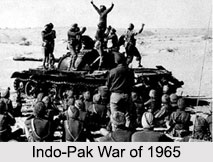 Indo Pak War was against the Pakistani forces in 1965. The Chhamb sector was attacked by the Pakistanis. It was the second war fought between India and Pakistan and saw an unprecedented engagement of troops in the disputed regions. This military operation was named as "Operation Riddle". Pakistan posed a grave threat to Indian forces on the ground and so, in response to urgent requests for air strikes against Pakistani armour advancing in the Chhamb-Jaurian sector. 28th Aug 1965, the day India captured Haji Pir Pass was the turning point in the Indo-Pak War of 1965 and is considered as victory day, though the war ended with a ceasefire.
Indo Pak War was against the Pakistani forces in 1965. The Chhamb sector was attacked by the Pakistanis. It was the second war fought between India and Pakistan and saw an unprecedented engagement of troops in the disputed regions. This military operation was named as "Operation Riddle". Pakistan posed a grave threat to Indian forces on the ground and so, in response to urgent requests for air strikes against Pakistani armour advancing in the Chhamb-Jaurian sector. 28th Aug 1965, the day India captured Haji Pir Pass was the turning point in the Indo-Pak War of 1965 and is considered as victory day, though the war ended with a ceasefire.
Beginning of the Indo Pak War, 1965
The first inklings of the war began with the dispute over the Rann of Kutch. In April 1965, intermittent attacks and war broke out between the two nations. Pakistan attempted to annex the territory which was originally controlled by India. In June 1965, there was a ceasefire and subsequently a tribunal, following the intervention of Britain. The success of Pakistan in this combat along with the disastrous losses faced by India in the 1962 Indo-Sino War convinced Pakistani military officials that they could successfully launch a campaign to capture the state of Jammu and Kashmir.
In August, "Operation Gibraltar" launched by Pakistan was a strategy to infiltrate Jammu and Kashmir and provoke a rebellion against Indian rule. The operation, however, was unsuccessful and Indian troops retaliated by launching a full-scale attack on Pakistan on August 15th. Initially, the conflict was confined to the regions of Kashmir and Punjab. By the end of August, both countries seemed to have equal footing with Pakistan controlling the regions of Tithwal, Uri and Poonch and Indian recapturing Haji Pir Pass.
In September, Pakistan launched "Operation Grand Slam", following which the Battle of Chhamb was fought, marking a huge success for Pakistan in Akhnoor. In September, Indian troops crossed the International Border on the West, marking the official start of the war. The attack followed a three point invasion by Indian troops towards the city of Lahore. The Indian forces pushed an offensive towards Sialkot, while the Pakistani forces pushed towards Khem Karan. This battle was a turning point of the war and proved a win for India.
The Soviet Union and the U.S. grew wary of the rising conflict and pressurised the countries to sign a ceasefire. With the heavy casualties and declining ammunition along with international pressure, the former Prime Minister of India, Lal Bahadur Shastri and the President of Pakistan Ayub Khan, signed the Tashkent Agreement. The battle eventually ended in a standstill. India witnessed casualties of about 3000 soldiers, 150 tanks and nearly 70 aircrafts.



















